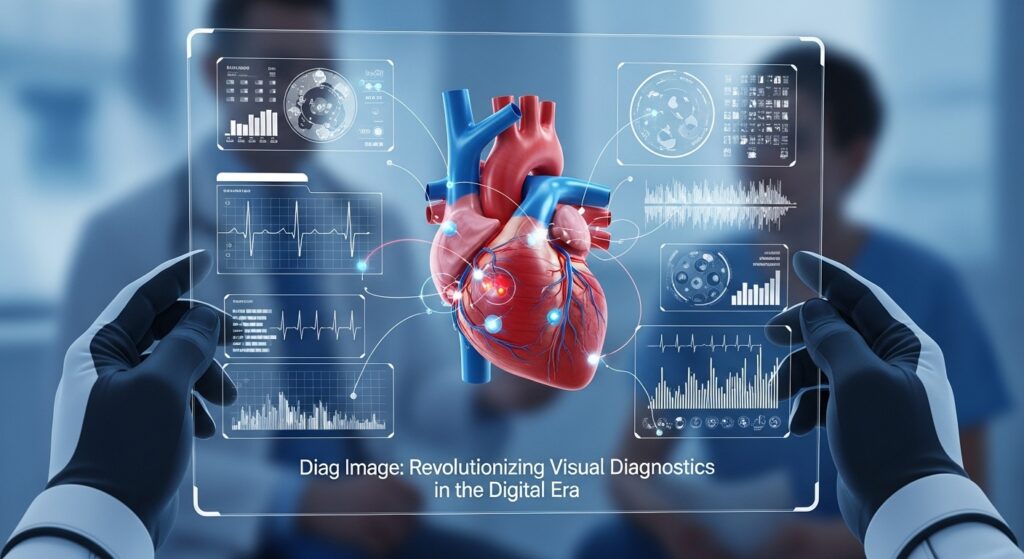In today’s data-driven world, Diag Image has emerged as a transformative tool for visual diagnostics and image interpretation. The term “Diag Image” combines “diagnostic” and “image,” representing a new generation of digital imaging technologies powered by artificial intelligence (AI), computer vision, and data analytics. These systems are redefining the way industries—especially healthcare, engineering, and research—analyze and interpret complex visual data.
From medical scans to industrial inspection systems, Diag Image tools enable professionals to extract insights, detect anomalies, and enhance decision-making accuracy. By integrating machine learning with imaging hardware, Diag Image solutions bridge the gap between human perception and digital intelligence.
Understanding the Concept of Diag Image
Diag Image is not just about capturing pictures; it is about intelligent visualization. It transforms visual information into structured, meaningful data. In essence, Diag Image represents the process of using advanced algorithms to interpret and diagnose images efficiently.
Below is a simple comparison illustrating the difference between Traditional Imaging and Diag Image technology.
| Feature | Traditional Imaging | Diag Image |
|---|---|---|
| Data Processing | Manual Analysis | Automated, AI-driven |
| Accuracy | Subject to Human Error | High Precision |
| Speed | Time-Consuming | Real-Time |
| Adaptability | Limited | Continuously Learning |
| Applications | Basic Scanning | Predictive & Diagnostic Analysis |
This table clearly highlights how Diag technology takes visual interpretation to a whole new level, saving time while improving accuracy across various fields.
Applications of Diag Image in Healthcare
The healthcare industry is one of the biggest beneficiaries of Diag innovation. With the rise of digital radiology and AI-powered diagnostic systems, medical professionals now rely on imaging tools to identify diseases more accurately and at earlier stages.
Diag systems analyze medical scans—such as MRI, CT, X-rays, and ultrasounds—using deep learning models that can detect patterns and abnormalities invisible to the naked eye. This technology not only enhances diagnostic accuracy but also supports faster clinical decisions.
Key Benefits of Diag Image in Medicine
-
Early Disease Detection: Diag algorithms can identify early-stage tumors or infections before symptoms appear.
-
Remote Diagnostics: Specialists can assess medical images from anywhere, enabling global access to healthcare.
-
Efficiency: Automated analysis reduces the burden on radiologists and improves workflow.
According to a report by healthcare analytics experts, facilities using Diag solutions have seen a 30% improvement in diagnostic speed and a 25% reduction in false-positive results.
Diag Image in Engineering and Manufacturing
Beyond healthcare, Diag Imag plays a crucial role in industrial quality control and engineering diagnostics. Modern factories use smart cameras and sensors integrated with Diag algorithms to detect surface defects, measure product dimensions, and ensure consistency in production.
These tools are essential in fields like aerospace, automotive, and electronics manufacturing, where precision and safety are critical.
| Industry | Application of Diag Image | Outcome |
|---|---|---|
| Automotive | Inspecting welds, coatings, and paint finishes | Enhanced quality control |
| Aerospace | Structural integrity checks | Reduced component failure |
| Electronics | Circuit board examination | Improved product reliability |
With real-time inspection and predictive maintenance capabilities, Diag enables industries to minimize downtime and maintain top-tier production standards.
How Diag Image Enhances Research and Development
In research environments, Diag tools help scientists visualize microscopic elements, model complex systems, and monitor chemical reactions in real time. From biological research to material science, Diag assists in generating accurate, high-resolution visual data.
Researchers benefit from automated pattern recognition, segmentation, and data annotation—allowing them to focus on discoveries rather than data preparation. For instance, in genomics, Diag technology can analyze DNA microarrays, while in astronomy, it can map celestial patterns using AI-driven imaging models.
The Role of Artificial Intelligence in Diag Image
Artificial intelligence is the backbone of Diag Imae systems. It empowers machines to analyze millions of visual data points, identify objects, and classify patterns. AI models used in Diag solutions typically include:
-
Convolutional Neural Networks (CNNs): For image classification and feature extraction.
-
Generative Adversarial Networks (GANs): For generating realistic synthetic images.
-
Reinforcement Learning: For improving image analysis over time.
By training these models on diverse datasets, Diag systems achieve exceptional accuracy, making them reliable for mission-critical applications. AI ensures that these systems continue to evolve, learning from each image processed.
Diag Image and Data Security
While Diag Image technology offers remarkable advantages, it also raises concerns about data privacy and cybersecurity. Since many diagnostic images contain sensitive information—especially in healthcare—organizations must implement encryption, access control, and anonymization protocols.
To safeguard data, most Diag systems use:
-
End-to-end encryption to protect image data in transit.
-
Secure cloud platforms for image storage and retrieval.
-
AI-driven anomaly detection to identify unauthorized access attempts.
By maintaining strict compliance with data protection standards such as HIPAA and GDPR, Diag systems ensure trust and transparency in their operations.
Diag Image in Education and Training
Another significant application of Diag Image is in education and skill development. Medical schools, engineering programs, and research institutes use these imaging tools for interactive learning. Trainees can analyze real-world case images, understand structural details, and practice digital diagnostics without physical specimens.
For example, in virtual anatomy labs, Diag software can generate 3D reconstructions of organs, enabling medical students to perform virtual dissections. In engineering, students can explore structural simulations and failure patterns through detailed imaging models.
Such advancements make education more accessible and immersive, bridging the gap between theory and practical application.
Advantages and Challenges of Diag Image
| Advantages | Challenges |
|---|---|
| High Accuracy and Speed | High Implementation Cost |
| Reduced Human Error | Requires Large Datasets |
| Scalable Across Industries | Data Privacy Concerns |
| Real-Time Analysis | Need for Skilled Professionals |
While the advantages of Diag are substantial, its success depends on proper implementation, reliable data sources, and skilled users capable of interpreting AI-driven insights.
Future of Diag Image Technology
The future of Diag Image lies in its integration with augmented reality (AR), 3D modeling, and quantum computing. With ongoing innovation, Diag will not only diagnose but also predict complex outcomes based on visual data trends.
Imagine a scenario where a Diag system analyzes environmental changes from satellite images to predict natural disasters or assesses patient health through facial recognition of symptoms. Such innovations are already in development, marking a new era in image intelligence.
Conclusion
In conclusion, Diag Image is more than just a technological trend—it represents the future of intelligent imaging and diagnostics. By combining AI, data analytics, and high-resolution visualization, Diag enhances accuracy, efficiency, and decision-making across healthcare, industry, and research.
As technology continues to evolve, Diag will play a central role in shaping smarter, data-driven societies. It stands as a symbol of precision, innovation, and digital intelligence—empowering humans to see, understand, and act better through the power of images.






